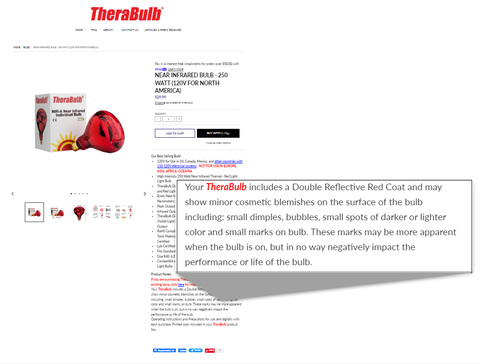Why Bulb Color and Performance are Unrelated
"Pretty solid. The main reason I had to return these was because some of them had some imperfections, and were not evenly colored. Or else I would’ve kept them."
Some of you may wonder why we're starting a blog post with a negative review. The reason is very simple: we are committed to transparency and consumer education. We don't want other customers to be just as disappointed as this one was. As the review states there may be color inconsistencies among our bulbs. That's a fact that we're not only admitting in this blog post, but we also include in our product descriptions.

This may lead to another why: why do we sell bulbs that we know have color variations? The answer to that question is that our bulbs are designed for performance. Specifically, they are designed and tested to maximize red light and near infrared output and intensity, both of which are produced by the filament and not the glass shell. That's right: despite being red in color, (more about that below) the glass that encases the filament plays zero role in the production of red light or infrared energy.
How Lightbulbs Work
Incandescent lightbulbs, such as those in our zero-EMF collection (Near Infrared Bulb - 150 Watt, Near Infrared Bulb - 250 Watt, and Near Infrared Bulb - 300 Watt) produce heat, visible light (including red light) and near infrared energy as the result of electrical current passing through a metal filament, causing it to glow. The image below shows the filament inside of a TheraBulb.

This method of operation is also why TheraBulb incandescent bulbs, and all other traditional incandescent bulbs, are zero-EMF bulbs. The simple technology they are based upon does not create the conditions that produce EMF. We've had an independent ISO 17025 accredited lab confirm that our bulbs produce zero EMF.
The Purpose of the Glass Shell and the Reason It Is Red
Glass shells (the "bulb" part of the lightbulb) encase the light/energy/heat-producing filament. The shell protects the filament from damage and protects the users from contact with the filament, which can return reach temperatures well in excess of the bulb's operating temperature. The shell in combination with the metal base also keeps oxygen from coming into contact with the filament, as contact with oxygen will cause the filament to burn up.
As for the color of the shell? The red color is an industry standard for infrared bulbs, but not entirely universal, as some manufacturers produce clear near infrared bulbs. The red color also helps dampen some of the brightness of the bulbs by filtering out some non-red visible light.
Decorator Bulbs Versus TheraBulbs
TheraBulbs are not decorator bulbs, and decorator bulbs are not near infrared bulbs. Decorator bulbs are designed to look great when dark and when lit. Near infrared bulbs are designed to be viewed through infrared filtering eyewear when lit and are not intended to contribute to home decor.
If you are looking for red bulbs for aesthetic purposes, we recommend purchasing a much less expensive red light party bulb. If you are looking for a bulb that is lab-verified to emit red light, near infrared, and heat, TheraBulb is the bulb you are looking for. Order yours today.


